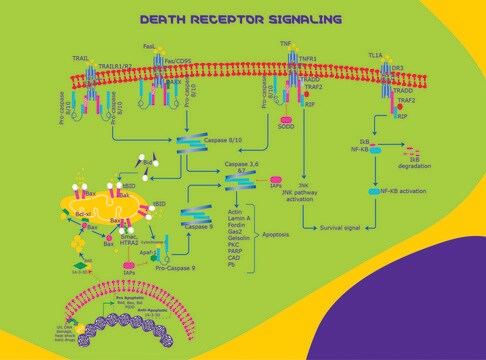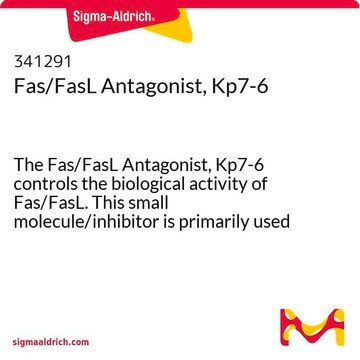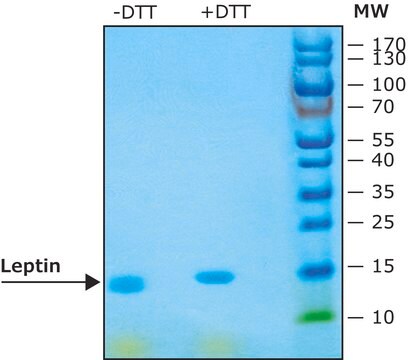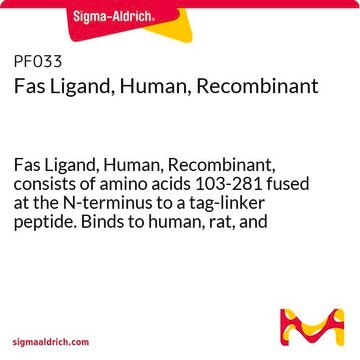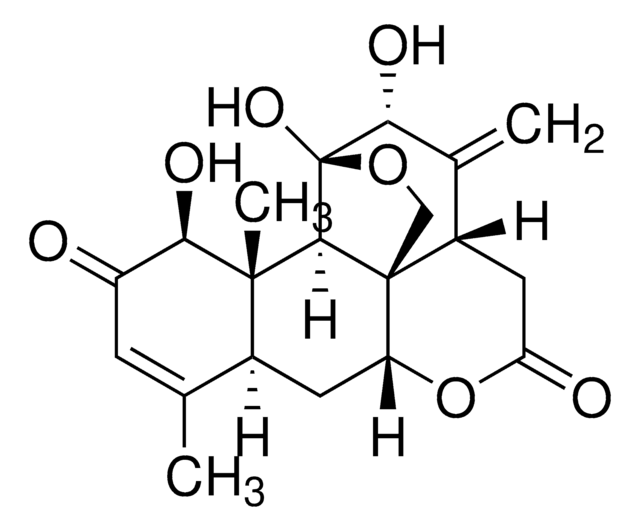Alle Fotos(1)
Wichtige Dokumente
F0552
Fas Ligand from mouse
>95% (SDS-PAGE), recombinant, expressed in mouse NSO cells, lyophilized powder
Anmeldenzur Ansicht organisationsspezifischer und vertraglich vereinbarter Preise
Alle Fotos(1)
About This Item
Empfohlene Produkte
Rekombinant
expressed in mouse NSO cells
Qualitätsniveau
Assay
>95% (SDS-PAGE)
Form
lyophilized powder
Mol-Gew.
monomer calculated mol wt ~18 kDa
28-32 kDa by SDS-PAGE
Verunreinigungen
endotoxin, tested
UniProt-Hinterlegungsnummer
Lagertemp.
−20°C
Angaben zum Gen
mouse ... Fasl(14103)
Allgemeine Beschreibung
FASLG (Fas ligand) acts as a ligand for Fas receptor, and is a major protein involved in programmed cell death, apoptosis. Soluble Fas (sFAS) is usually detected in plasma prior to apoptosis.
Anwendung
Fas Ligand (FASLG) from mouse has been used for-
- the induction of apoptosis in PC12 cells and
- the induction of migration in BV-2 murine microglial cells.
Biochem./physiol. Wirkung
FASLG (Fas ligand) and Fas receptor constitute the basic elements in apoptosis. Interaction of FASLG with Fas receptor leads to activation of caspase-8. This caspase in turn leads to activation of effector caspases such as caspase-3, -6 and -7. This cascade results in the hydrolysis of nuclear and cytoplasmic components. Expression of FASLG is induced by nuclear factor-κB (NFκB). NFκB/FASLG pathway facilitates the suppression of p,p′-DDT (dichlorodiphenoxytrichloroethane)-induced cell toxicity by vitamin C and E. In CD4+ T cells, this protein is expressed on stimulus by T-cell receptor (TCR), both during normal and pathological conditions, such as alcohol exposure.
Fas ligand, a protein belonging to the tumor necrosis factor (TNF) family of cytokines, induces apoptosis in cells expressing the cell membrane receptor Fas (CD95/Apo-1).
Protein belonging to the tumor necrosis factor (TNF) family of cytokines; induces apoptosis in cells expressing the cell membrane receptor Fas (CD95/Apo-1).
Sonstige Hinweise
Mouse Fas Ligand, N-terminal 6X histidine-tagged, encodes amino acid residues 132-279.
Physikalische Form
Lyophilized from a 0.2 μm filtered solution in phosphate buffered saline containing 2.5 mg bovine serum albumin.
Hinweis zur Analyse
Measured by its ability to induce apoptosis in Jurkat cells.
Lagerklassenschlüssel
10 - Combustible liquids
WGK
WGK 3
Flammpunkt (°F)
Not applicable
Flammpunkt (°C)
Not applicable
Hier finden Sie alle aktuellen Versionen:
Besitzen Sie dieses Produkt bereits?
In der Dokumentenbibliothek finden Sie die Dokumentation zu den Produkten, die Sie kürzlich erworben haben.
Xiaoting Jin et al.
PloS one, 9(12), e113257-e113257 (2014-12-03)
Dichlorodiphenoxytrichloroethane (DDT) is a known persistent organic pollutant and liver damage toxicant. However, there has been little emphasis on the mechanism underlying liver damage toxicity of DDT and the relevant effective inhibitors. Hence, the present study was conducted to explore
Aleksander Szymanowski et al.
Atherosclerosis, 233(2), 616-622 (2014-02-19)
Apoptosis of natural killer (NK) cells is increased in patients with coronary artery disease (CAD) and may explain why NK cell levels are altered in these patients. Soluble forms of Fas and Fas ligand (L) are considered as markers of
Nicole Suyun Liu et al.
PloS one, 7(8), e43180-e43180 (2012-08-21)
Diva is a member of the Bcl2 family but its function in apoptosis remains largely unclear because of its specific expression found within limited adult tissues. Previous overexpression studies done on various cell lines yielded conflicting conclusions pertaining to its
Ying-mei Lu et al.
Journal of neuroinflammation, 9, 172-172 (2012-07-14)
The cerebral microvascular occlusion elicits microvascular injury which mimics the different degrees of stroke severity observed in patients, but the mechanisms underlying these embolic injuries are far from understood. The Fas ligand (FasL)-Fas system has been implicated in a number
Smita S Ghare et al.
Journal of immunology (Baltimore, Md. : 1950), 193(1), 412-421 (2014-06-06)
Activation-induced Fas ligand (FasL) mRNA expression in CD4+ T cells is mainly controlled at transcriptional initiation. To elucidate the epigenetic mechanisms regulating physiologic and pathologic FasL transcription, TCR stimulation-responsive promoter histone modifications in normal and alcohol-exposed primary human CD4+ T
Unser Team von Wissenschaftlern verfügt über Erfahrung in allen Forschungsbereichen einschließlich Life Science, Materialwissenschaften, chemischer Synthese, Chromatographie, Analytik und vielen mehr..
Setzen Sie sich mit dem technischen Dienst in Verbindung.